 Low Maintenance Ponding...
Low Maintenance Ponding... Low Maintenance Ponding...
Low Maintenance Ponding...I've got the Speedos and the shades on because I'm going out to do a bit of cleaning. If you're going to clean a pond properly, you have to get wet... Got my shades, my bag of plant tools, fertilizer, and fish food. And I've got my net. But this page isn't about how to maintain a pond. It's more about how to keep that maintenance to a minimum... If you've read the rest of my page, there probably isn't much on this page that you haven't seen. It all ties together. Most people that read my web site jump straight to the Building section. Then I get all sorts of questions that are answered in the other sections. Let's face it. Building is really easy. It's the other stuff that's difficult and what you need to spend so much time on. And since you've probably skipped my other pages, I'm not as concerned that I repeated myself... (But really, there is a lot of good stuff on the other pages!)
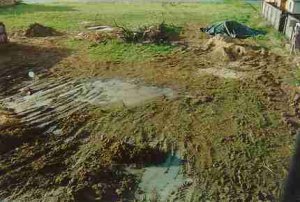 If
you want to go from this to this
If
you want to go from this to this 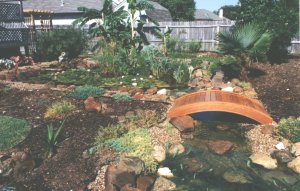 ,
and have it be pretty trouble free, you've got to spend more time on Thinking,
Research, and Planning. Low maintenance ponding
starts before you've dug your first shovel full of dirt. That's why
I stress thinking, planning, and research so much in my seminars, on this
web page and in my magazine articles. It relates directly back to
design. If you don't want to spend every spare minute of your life
taking care of your garden, then you have to PLAN to take care of it. Everything
you do to your pond will help you or hurt you down the road. I don't
spend more than an average of an hour a week during the growing season
taking care of my 3 ponds. I have clear water and healthy fish 24/7/365
and have had for the last 6 years, since I went organic and figured out
about all that really bad information out there...
,
and have it be pretty trouble free, you've got to spend more time on Thinking,
Research, and Planning. Low maintenance ponding
starts before you've dug your first shovel full of dirt. That's why
I stress thinking, planning, and research so much in my seminars, on this
web page and in my magazine articles. It relates directly back to
design. If you don't want to spend every spare minute of your life
taking care of your garden, then you have to PLAN to take care of it. Everything
you do to your pond will help you or hurt you down the road. I don't
spend more than an average of an hour a week during the growing season
taking care of my 3 ponds. I have clear water and healthy fish 24/7/365
and have had for the last 6 years, since I went organic and figured out
about all that really bad information out there...
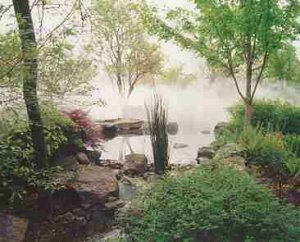 Let's
start at the basics. Where you place your pond makes a lot of difference.
Sure your pond will look beautiful under that copse of trees,
but you'll be spending more time scooping out leaves - unless you install
a skimmer. That low spot in the yard may seem the perfect
place for a pond since it's already soggy, but unless you raise the edge
to keep OUT all that rain water runoff, you're in for a really big mess.
If you stop to think what's in that runoff, fertilizer, herbicides, insecticides,
dirt, dog and cat poop from all over the neighborhood you'll know why you
want to keep ground runoff out of your pond.
Let's
start at the basics. Where you place your pond makes a lot of difference.
Sure your pond will look beautiful under that copse of trees,
but you'll be spending more time scooping out leaves - unless you install
a skimmer. That low spot in the yard may seem the perfect
place for a pond since it's already soggy, but unless you raise the edge
to keep OUT all that rain water runoff, you're in for a really big mess.
If you stop to think what's in that runoff, fertilizer, herbicides, insecticides,
dirt, dog and cat poop from all over the neighborhood you'll know why you
want to keep ground runoff out of your pond.
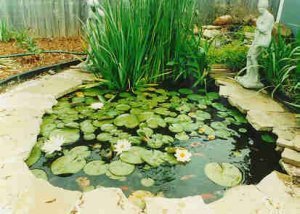 Or how
about size?Any ponder
Or how
about size?Any ponder 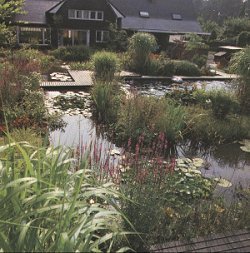 will tell you that the only regret that they had about putting in that
last pond is that they didn't make it bigger. Let me tell you, a
bigger pond is easier to take care of than a small pond. Think about
it. With a small pond, you're going to be spending a lot of time
kneeling on your edging, reaching down into the water pinching off leaves
and spent blooms, fertilizing, maintaining the pump and all sorts of other
chores. On the other hand, if the pond is larger, say 8x10x2.5 minimum,
there's room to get down into the pond.
will tell you that the only regret that they had about putting in that
last pond is that they didn't make it bigger. Let me tell you, a
bigger pond is easier to take care of than a small pond. Think about
it. With a small pond, you're going to be spending a lot of time
kneeling on your edging, reaching down into the water pinching off leaves
and spent blooms, fertilizing, maintaining the pump and all sorts of other
chores. On the other hand, if the pond is larger, say 8x10x2.5 minimum,
there's room to get down into the pond.
Now all those plants are at waist level! No more bending
over! Itís also easier to get a net around the bottom to get muck
out if it's not crammed with plants. The larger size also means that
there's more water volume. Remember this, "the solution to pollution
is dilution." Your fish are producing waste. When you concentrate
it, you're asking for trouble, hence more maintenance. The greater
depth also helps. You get more volume and you have to raise the plants
up off the bottom of the pond, easier maintenance. You're also getting
more benefit from thermal warming in winter and thermal cooling in the
summer so your fish are happier. And happier fish are healthier fish.
And a healthy fish is a low maintenance fish.
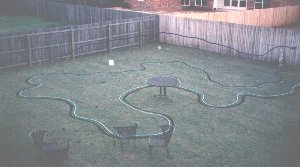 Shape.
Complex
Shape.
Complex 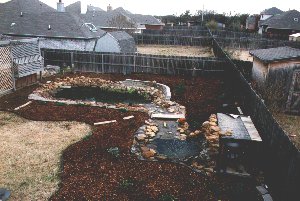 shapes mean more difficulty in getting good water circulation. This
can result in dead spots in the water where the nasty dissolved gasses
can build up. Not good because that also relates back to sick fish
and other nastiness. Stay with the simple shapes. And the benefit
is that you get more volume for the same liner.
shapes mean more difficulty in getting good water circulation. This
can result in dead spots in the water where the nasty dissolved gasses
can build up. Not good because that also relates back to sick fish
and other nastiness. Stay with the simple shapes. And the benefit
is that you get more volume for the same liner.
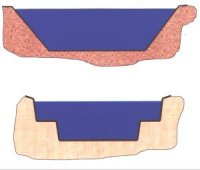 Sloping
walls and plant shelves
Sloping
walls and plant shelves 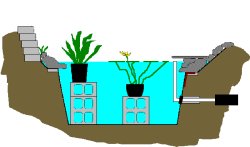 dug
into the pond wall!! Nasty things. Think about the critters
that want to get in your pond. Most animals wanting to get in your
pond will reach out with whatever leading appendage they have and see if
they can touch bottom. If they can, they know they can get out.
There is only one animal that will get in a pond without checking it first
and that's a bird dog. So if you have those dirt plant shelves or
sloping sides, you're letting the critters in your pond to wreak all kinds
of havoc. With the dirt plant shelves, you're also resigning yourself
later to design decisions you make when you don't know what the heck you're
doing. And besides, the shelves will crumble over time into sloping
sides. Besides, straight sides and no dirt plant shelves mean what?
More volume. Instead of dirt shelves, build some simple stands out of pvc
pipe. Fill it with sand and punch some holes in it to let the air out so
they don't float. (I used to recommend stacks of painted concrete blocks
but the pvc is MUCH better) and untreated 2x6's. Really, you can use just
about anything plastic like stacked milk crates. If you want to remodel, you
just have to move the boards. And these shelves give the fish a place
to hide from aerial predators.
dug
into the pond wall!! Nasty things. Think about the critters
that want to get in your pond. Most animals wanting to get in your
pond will reach out with whatever leading appendage they have and see if
they can touch bottom. If they can, they know they can get out.
There is only one animal that will get in a pond without checking it first
and that's a bird dog. So if you have those dirt plant shelves or
sloping sides, you're letting the critters in your pond to wreak all kinds
of havoc. With the dirt plant shelves, you're also resigning yourself
later to design decisions you make when you don't know what the heck you're
doing. And besides, the shelves will crumble over time into sloping
sides. Besides, straight sides and no dirt plant shelves mean what?
More volume. Instead of dirt shelves, build some simple stands out of pvc
pipe. Fill it with sand and punch some holes in it to let the air out so
they don't float. (I used to recommend stacks of painted concrete blocks
but the pvc is MUCH better) and untreated 2x6's. Really, you can use just
about anything plastic like stacked milk crates. If you want to remodel, you
just have to move the boards. And these shelves give the fish a place
to hide from aerial predators.
We were just talking rain. When you install that pond, you'd better think about how you're going to handle excess rain or you're in for more maintenance. Just letting the pond overflow isn't the answer since it'll wash in all that mulch you have in the beds around your pond. Nope, never install a pond without an overflow. Or how about a bottom drain of some sort? It's a dandy way to help suck up all that muck that's accumulating on the pond bottom. Get it into that filter where it's easier to clean out...
How about filtration? This is something else that you must consider BEFORE you start digging because it's frequently not something you can add later unless you've planned for it. Filtration can be a major part of keeping your pond water clean. The following rant and rave is solely the opinion of the writer. The problem is that most commercial filters are a real maintenance headache because they're designed wrong. I've even seen one brand of filter that looks like something out of Dr. Demento's basement. The filter makers are coming from an aquarium background and usually their pond filters are just big aquarium filters. This is all wrong. An aquarium is a much cleaner environment than your pond and those aquarium designs aren't equipped to handle the extra mechanical load. If you have to disassemble your 1/2 gallon filter for your little 50 gallon aquarium, no big deal. That same philosophy applied to a 1000-gallon pond is nuts. If you have to disassemble your filter, or it's difficult to get to, you aren't going to do it very often. Or if your filter is designed so poorly that it's always clogged, you're going to be spending WAY too much time maintaining the pond and you'll blame the pond. Filtration is not rocket science but the complex designs and exorbitant prices being charged lead me to believe that the filter manufacturers think it is. There. I sure feel better.
Here's a quickie "Filtration 101" for the neophytes. There are 2 types of filtration that may be needed in a pond. I say "may" because filtration is not always necessary, just desired. The first type is mechanical filtration. This type removes particles that are suspended in the water. Those particles are trapped in the filter and then removed when the filter is cleaned. Mechanical filtration can be as complex as a series of separators and screens, or as simple as a strainer. It depends on how big the particles are that you want to filter and how much maintenance that you want to do.
The other type of filtration is biological filtration. Your fish produce waste, both solid and liquid. The solid is taken care of with mechanical filtration. The liquid, mainly ammonia, is toxic and must be addressed. There are a couple of types of bacteria that work in concert to convert this ammonia to nitrites then to nitrates. Nitrates, in normal amounts, are not toxic to fish. This bacteria grows on everything in the water. Drop a stone in a clear mountain stream. If you pick it up immediately, you can still feel friction when you rub it with your finger. Pick up that same stone a day later and it will feel slick. This slick coating is the beneficial bacteria. In nature, the fish to water ratios are really low and there is enough of this bacteria on the surface of everything in the water to work on this process. Our ponds are usually stocked to a much higher level and there aren't enough surfaces in the water for the bacteria to grow. This is where biological filtration comes in. A biofilter is just a big container filled with material that has a lot of surface area. For more, take a jump over to my Planning page...
Filter media is also a factor in the ease of maintenance of your filter. I've heard of sand, gravel, lava rock and all sorts of other materials. These seem like a quick and inexpensive alternative, but in the long run, they are no substitute for a purpose-built material like bioballs or bioribbon and may even cost more. Sand and gravel are both relatively fine materials and provide a lot of surface area and do a good job of mechanical filtration. However, they are heavy and hard to clean so they clog up quickly and you lose all the benefits. Lava rock is a lighter material and looks like it has a lot of surface area, but after a few months in the filter, all those nooks and crannies are filled up with muck and what you're left with is basically large gravel. It's also a bear to clean. The matting and foam fillers seem good but you have to remove them to clean the filter and if the material is not specifically made for pond filters, microscopic bits may flake off and end up in the pond where it'll tear up your fish. The effect is something like what asbestos does to the lungs of humans. I use both bioribbon and bioballs and can tell you that they're easy to clean in the filter with just a hose. They both provide an abundance of surface area and do a good job of slowing down the water for mechanical filtration. In my humble opinion, it's worth the money to go with a proper biological medium.
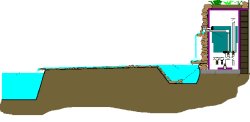 A last
bit on filtration is back to design of the actual pond. In
my own pond, I've incorporated a pond just after my waterfall and a stream.
The pond serves as a settlement pond. It's filled with my anacharis
and cabomba with a little parrot's feather thrown on top for looks.
Any muck that makes it through my filter will end up settling out in my
settlement pond. And keeping the anacharis away from my fish means
that I have more anacharis because the fish aren't eating it. That's
my filtration sermon.
A last
bit on filtration is back to design of the actual pond. In
my own pond, I've incorporated a pond just after my waterfall and a stream.
The pond serves as a settlement pond. It's filled with my anacharis
and cabomba with a little parrot's feather thrown on top for looks.
Any muck that makes it through my filter will end up settling out in my
settlement pond. And keeping the anacharis away from my fish means
that I have more anacharis because the fish aren't eating it. That's
my filtration sermon.
And that's just a few things to consider BEFORE you start digging. Most of that stuff is hard to install or rectify after the fact. Now let's talk a bit about water quality. I take an organic approach. To quote from the Ponder's Bible, Book of Chuck, Chapter 15, verses 9-12. "Put not those things into your pond that you cannot remove lest it be of need most dire. For verily I say unto you, those things will gather into abundance and there will be a great gnashing of teeth." The exception to this rule is fish pharmaceuticals. By the same token, NOT adding a bunch of junk to the water means that the water is really healthier in the long run and you don't have to think about getting all that added junk out of the water. If you haven't been messing with the water, and everything else is going right, the best water for your pond is the water that's already in there so don't do water changes! It stresses the fish and messes with the chemistry. This just leads to problems. It's a lot easier to prevent the problems than trying to fix them after the fact.
And the vendors really want us to add all kinds of stuff to our ponds. Every time you turn around there's a new quick fix to a problem. And more frequently than not, that quick fix will just cause another problem that you'll have to take care of later... For instance, how many of you add dechlorinator to your water when you top it off? Do you know what it does? Does it build up in the water and affect your chemistry? How about this? Most of our water has chlorine and ammonia in it, some more than others. In Ft. Worth, I have more chlorine in my tap water than most people have in their pools! They do this because chlorine by itself will evaporate and the combination won't so they have to add fewer chemicals. The dechlorinator works by breaking the bond between the chlorine and ammonia molecules. The chlorine can evaporate away and the filter can convert the ammonia. But what does it convert to? Nitrates! And what do they do in your water? They feed algae! So adding dechlor not only adds something to the pond that you can't get rid of, but it exacerbates the biggest problem we all face ALGAE!!! So let's go back to my adage. Rather than try to fix a problem by adding a bunch of junk that will cause more problems, why don't we keep the problem from getting in there in the first place? I've talked about this in a lot of places. I've built a filter that goes on my hose. It's a simple filter that has a taste and odor cartridge in it. This removes the chlorine and ammonia before it gets in the pond. If you're using well water or your water supply has other stuff in it, there are other cartridges that you can get to remove heavy metals and other junk.
While we're on the topic of algae, let me digress a bit and give my algae sermon. If I get 300 e-mails a week, 200 of them will be about algae. You can buy algaecides, UV lights, "miracle" magnets and all kinds of other stuff. As I said earlier, I have clear water 365 days a year and I don't use any of that stuff. As with most ponding things, the answer is simple if you take a minute to stop and think about it and that's the biggest problem with most ponders. We don't really stop to think about the CAUSE of a problem. More on that later. Anyway, algae... It's nothing more than a plant. And the lowest plant on the totem pole at that! As a plant, it needs the same things as all other plants to grow, namely water, sunlight, and nutrients. If you want to keep a plant from growing, you have to address at least 2 of the legs of that stool. We can't get rid of the water and still have a pond so we have to address the others. Sunlight. That's what the water lilies are for. Coverage of your pond of at least 60% will go a great distance in alleviating your algae problem. In spring, when your pond is just getting started, the lilies can't do their job so you can add something like Aquashade. This is a vegetable dye that works like sunglasses for your pond. And since it's a vegetable dye, it slowly decays over about 3 weeks and is then removed when you clean the pond bottom.
Now how about nutrients? The first thing is to keep the pond clean. What's all that junk in the bottom of your pond? The fish poop and dead leaves? It's fertilizer so get that junk out of there. And if the pond is big enough, it's easier to do. Once a week, take a fine mesh net and run it over 1/2 or 1/3 of your pond and scoop the muck out. If you really want to go organic, save the stuff and use it on your garden plants. But dilute it really heavily, this stuff is strong and will kill your plants. The same goes for your filter, clean it at least every 2 weeks during the season and once a month in the winter. And use that hose filter so you're using dechlorinated water on your filter so you don't kill all those biobugs. You can save this junk too, but if you want to get rid of it, plan ahead and dig yourself a trench for some 4 inch flexible drain pipe that runs off to a low area like the street and drain your filter into that. That'll take care of a lot of the solid nutrients but what about the nutrients dissolved in the water? For those, you need more plants. Oxygenating grasses like cabomba and elodea only have roots to anchor themselves to the bottom. They get their nutrients directly from the water. The more bunches you have, the better off you are. You need at least 2 bunches for every square foot of surface area. Elodea does a better job if you can keep the fish away from it. They don't like to eat the cabomba as much.
And while we're on algae, I'd like to take a minute to address UV lights. If they're working properly, they do 2 things. First they kill algae by exploding the algae cells. But now the algae is in smaller pieces and won't settle out in your filters. Instead, all the little pieces will decay much faster providing what? More food for more algae! The other thing they do is sterilize the water. But think about that sterile environment. If you lived in a bubble with totally sterile air all the time, the first time you get a visitor over and he sneezes you're sick. And it's not just a cold you're fighting now, but probably pneumonia and other stuff as well. Why? Your body didn't have any defenses built up so anything you came in contact with REALLY hit you. That's what UV does to your fish. Trust me, they'll be healthier without it. And they're also expensive and need to be maintained!
Alright, enough algae and back to maintenance. You'll seldom hear me recommend a product by name, this is one exception. For the last few years, I've been using a product called Microbe Lift PL. This is a veritable bacteria soup that I first started testing as a filter "kick start" for your Yankee brethren and sisteren. After a bit, I noticed that I had less muck in the bottom of the pond than usual and that the water seemed even clearer. I attended a seminar back in March where a representative of the company spoke. Even they're finding out more about the benefits of this stuff all the time. Yep, it does a great job of supplying the filter bugs, but there's also bugs in there that help to eat the bottom muck and others that work on nitrates. Fewer nitrates mean less algae. It also seems to help with string algae. And the best part is that it's just bacteria that would normally get in your pond eventually anyway. If they have nothing to eat, they die and you scoop them out when you clean out the pond.
Let's talk about another popular additive to ponds - salt. This is one that I really have a problem with. A lot of koi people add it because of a myth that it's beneficial for the fish. Let me be blunt. Salt has no business being in your pond. Koi don't have salt in their ponds in nature and they do just fine. Supposedly, salt is beneficial in that it removes parasites from the fish. In reality, it does this by causing the fish to slough their slime coat which takes the parasites with it. But a fish without a slime coat is susceptible to diseases, fungi and parasites so you have to add a little more salt to kill those. Trust me, the fish are better off with their slime coats. Another problem with the salt is that is stays in the water. It can build up to the point that is not only kills your plants, but also kills your fish. Because of that, people who add salt have to do water changes. Now they'll tell you that they do it because they "don't want their fish living in a toilet." In reality, if your filters are working properly and you have sufficient plants in the pond, your water is pretty clean. It might not be something we'd like to live in, but then we're not fish. The water you're adding is pretty dead and has a much different pH than the water already in the pond. It could also have all kinds of other stuff in it that you don't know about. The water that's in the pond is the best water for the fish; it's a known.
Goofy stuff, there's a lot of it out there. Every time you turn around, there's a company wanting to sell you the magic pill for your pond. So use your common sense and think about the claims these people are making. You'll save yourself a lot of money. For instance, there are people out there that will sell you a magic cure to get rid of algae. All you have to do is put these magnets around your pump line and your algae will automatically disappear. Then someone else came along with an electronic gadget that is better than magnets. You wrap these wires around your pipe and it creates a magnetic field that prevents the algae. And this is better than the magnets since it changes frequency thousands of times a minute so that the algae can't mutate to not be affected. Algae mutating? Doesn't this sound just like the guy at the fair that wants to add magnets to your fuel line to double your mileage? And there's even more of this junk floating around. Before you spend your money, think a bit...
Now there's a bunch more stuff on low maintenance around this web site, like the Tips and Other Stuff pages so be sure to check them out...
Copyright 2003 Chuck Rush